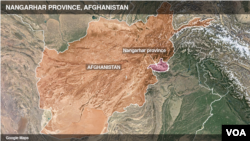The U.S. military dropped 555 bombs in Afghanistan against Taliban and Islamic State targets in August, the highest number in a single month since 2012.
Overall, the U.S. has conducted about 2,400 airstrikes since the beginning of the year in support of Afghan partners battling the Taliban and IS terrorists, said U.S. Navy Captain Bill Salvin, spokesman for NATO’s Resolute Support mission in the country.
About 1,700 of them were “strategic effects” strikes, Salvin told VOA, explaining "those are strikes that have an impact on the battlefield. They help the forces on the ground, essentially helping the ANDSF (Afghan National Defense Security Forces) take ground, hold ground and take the fight to the enemy."
Salvin said the spike in airstrikes conducted both by F-16 fighter planes and drones was facilitated by increased authority that the former U.S. administration under then-President Barack Obama gave last year to General John Nicholson, commander of international forces. The aim is to deny IS sanctuaries on Afghan soil and enable friendly ground forces to reverse Taliban battlefield gains.
Areas in eastern Nangarhar and in southern Helmand provinces have seen most of the kinetic strikes this year, the spokesman said.
Officials believe Khorasan Province, an Islamic State affiliate, has set up bases in southern districts of Nangarhar while a majority of districts in Helmand, the largest Afghan province and poppy-producing region, are controlled or influenced by the Taliban.
The record increase in U.S. airstrikes comes as President Donald Trump last month unveiled his long-awaited new strategy for the 16-year-old Afghan war, the United States' longest-running foreign military engagement.
The Trump plan requires a modest troop surge and increased foreign airpower for Afghan forces so they could step up operations against the Taliban and IS loyalists, prompting concerns that intensified hostilities may cause more civilian casualties.
The Taliban currently controls or influences more than 40 percent of Afghan territory, hosting a population of up to three million, according to latest U.S. military assessments.
The military “uplift” that President Trump announced, including increased airpower, has not had a significant direct impact as yet because most of it is in the process of coming into the (war) theater, said Salvin.
He said that most of the additional forces due to arrive in Afghanistan will be part of NATO’s train, advise and assist mission, but Salvin declined to discuss their number. U.S. defense officials have cited a figure of at least 3,900 forces likely to be part of the new plan.
Two American airstrikes in the last week of August killed at least 24 civilians and wounded 16 others, almost all of them women and children, according to a United Nations probe. The U.N. has already recorded a 43 percent rise in Afghan civilian casualties from aerial strikes in the first six months of 2017.







